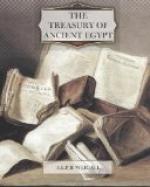Transcriber’s note: Original text read “sight”.
In the second place, a museum is a store-house for historical documents such as papyri and ostraca, and in this respect it is simply to be regarded as a kind of public library, capable of unlimited and perfectly legitimate expansion. Such objects are not often found by robbers in the tombs which they have violated, nor are they snatched from temples to which they belong. They are almost always found accidentally, and in a manner which precludes any possibility of their actual position having much significance. The immediate purchase, for example, by museum agents of the Tell el Amarna tablets—the correspondence of a great Pharaoh—which had been discovered by accident, and would perhaps have been destroyed, was most wise.
In the third place, a museum is a permanent exhibition for the instruction of the public, and for the enlightenment of students desirous of obtaining comparative knowledge in any one branch of their work, and for this purpose it should be well supplied not so much with original antiquities as with casts, facsimiles, models, and reproductions of all sorts.
To be a serviceable exhibition both for the student and the public a museum does not need to possess only original antiquities. On the contrary, as a repository for stray objects, a museum is not to be expected to have a complete series of original antiquities in any class, nor is it the business of the curator to attempt to fill up the gaps by purchase, except in special cases. To do so is to encourage the straying of other objects. The curator so often labours under the delusion that it is his first business to collect together as large a number as possible of valuable masterpieces. In reality that is a very secondary matter. His first business, if he is an Egyptologist, is to see that Egyptian masterpieces remain in Egypt so far as is practicable; and his next is to save what has irrevocably strayed from straying further. If the result of this policy is a poor collection, then he must devote so much the more time and money to obtaining facsimiles and reproductions. The keeper of a home for lost dogs does not search the city for a collie with red spots to complete his series of collies, or for a peculiarly elongated dachshund to head his procession of those animals. The fewer dogs he has got the better he is pleased, since this is an indication that a larger number are in safe keeping in their homes. The home of Egyptian antiquities is Egypt, a fact which will become more and more realised as travelling is facilitated.




